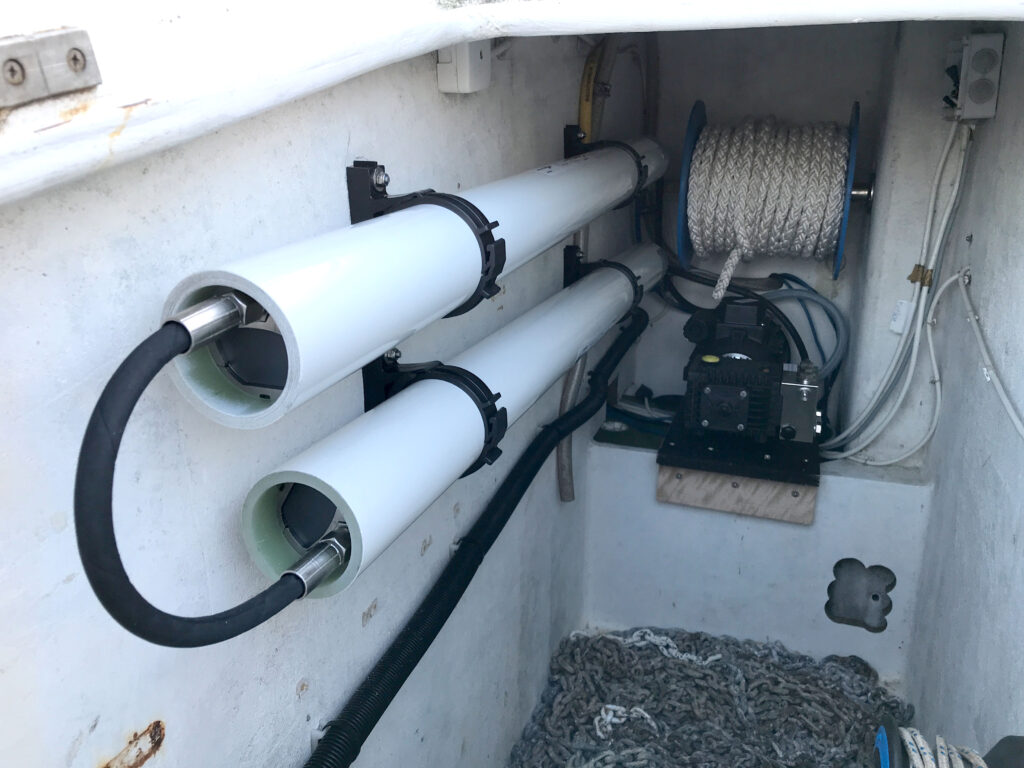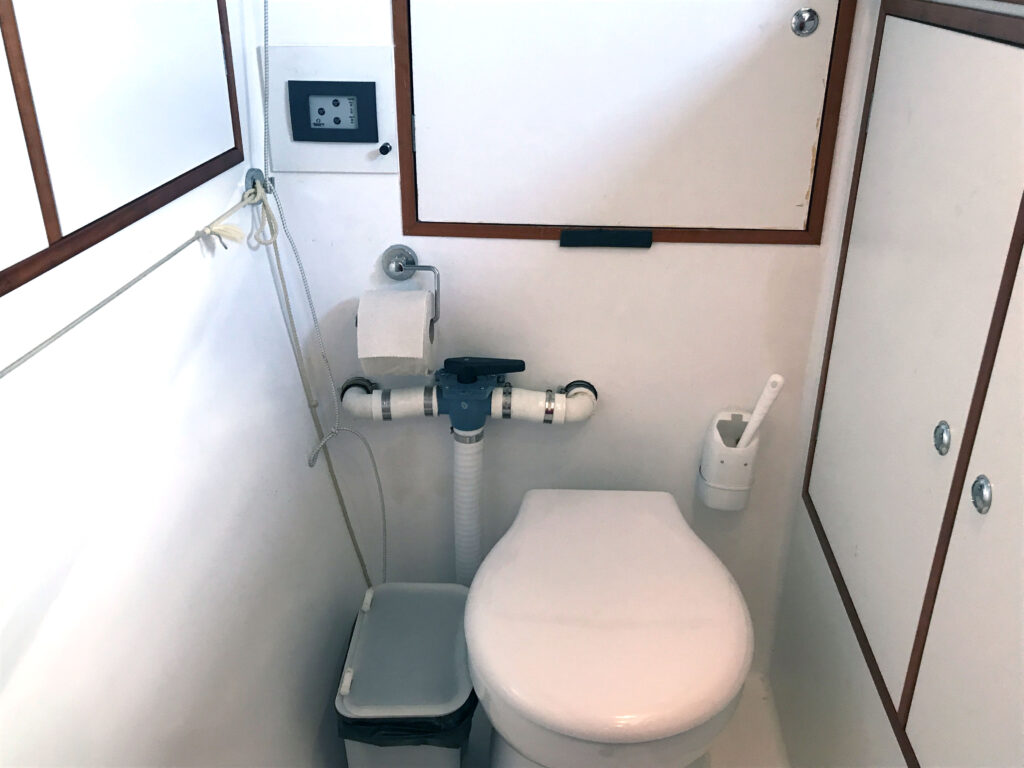Fresh Water
Good drinking water on board is essential for survival.
Our fresh water equipment
- 450 litres in two fresh water tanks
- 80 litre hot water boiler
- Aquatec watermaker 110 litres/hour
- Permanent water connection for the marina
- Whale Quick Connect system plumbing
- Whale Elegance fittings
- Multiple filter systems (paper and carbon filter inserts)
- Soda-Stream with reusable glass bottles for everyone on board
ADDITIONALLY FOR DISHWASHING AT SEA:
- Saltwater connection with outlet in the galley to save water when washing dishes, the connection with filter and pump is located behind the three-way sea valve of the port engine.
Our water logistics on previous ships
We have been sailing for 40 years. I cruised the Wadden Sea with a wooden pirate, my 16-foot dinghy cruiser or later with the 24-foot trimaran and always had a mobile 8-litre tank with a tap. The tank was placed in a locker next to the companionway, just above the sink, which was practical.
A black plastic bag served as a shower, which was warmed up in the sunshine and then hung up for showering pleasure. After clearing in at the harbour office, the first thing we did was to go to the nearest water tap.
We regularly encounter “water pirates” who row from the anchorage into the harbour at night equipped with all kinds of vessels in order to steal fresh water from the next unobserved tap, which the harbour berth holders then pay for.
But even with larger ships, water has to be used sparingly:
When we crossed the North Atlantic on the Viking Route with our 28m ketch Roter Sand, we had 5,000 litres in 3 different Niro tanks. After a week, I had to cut down on showering because the 11 crew members had already wasted 3 tonnes of it.
10 days later, when we arrived in St. John/Newfoundland, we still had 1 tonne left because we were thrifty! The command “Showers Free” was very much cheered by all.
Our logical water logistics today
The previous owners of our F41, a family of 4, sailed across the Atlantic and back with 450 litres in the water tanks and 10×20-litre canisters. As a fresh water reserve, they had stashed plastic water bottles in every corner, so another 250 litres=250kg more.
On board a catamaran, however, weight is crucial:
Half a tonne of extra weight means about 1.5 knots less average speed. We normally sail at an average speed of 10 knots. We already know the derogatory comments of the monohull sailors with lead carriers: that they don’t want to rush across the sea. We certainly don’t do that. However, in order to keep up with a weather system that moves you along perfectly, you have to be able to sail at 12-15 knots to avoid being caught up by the storm. A tonne of braking water is a risk we like to avoid. We have therefore considerably reduced our water weight by 400 litres: Reserve canisters banned and plastic water bottles banned for various reasons.
This is where the watermaker comes in:
The whole thing is supplemented by a watermaker, as is usual on all racers and modern long-distance riders. It weighs about 60 kilos and produces at least 110 litres of delicious, still mineral-rich and salt-free fresh water in an hour – depending on the local salt content in the sea and the temperature. We make a distinction between drinking and shower water, because the fresh water is filtered again. Our daily consumption for fresh water with a crew of two is 5 litres. We fizz it up in a morning routine with the Sodastream and fill it into glass bottles. This tastes great and provides good control for water consumption, which is important for health.
Daily showers (about 35 litres per shower) are thus quite feasible. There is always a reserve of 100 litres in the water tank on long journeys in addition to the 80 litres in the hot water boiler. When we sail with 4 to 6 people, the shower water consumption is reduced accordingly.
In the harbour we have a permanent pressure water connection, which reduces the shore water pressure to 2 bar with an appropriate reduction valve. To make the shore water taste good, we filter it with 2 carbon filters against chlorine and 5 micron paper filters for suspended matter. All filter housings are of the appropriate industry standard and of the same size.
At sea and at anchor, we use seawater for washing dishes, which is pumped to the kitchen sink from a depth of 1 metre.
Installation of the Aquatec water maker.
Wastewater systems on the F41
- 2 grey water tanks à 150 litres (galley and bathroom bilges)
- 2 black water tanks à 200 litres (forecastle BB/STB)
The subject of water also includes the subject of waste water. The F41 catamaran has a total of 2 grey water tanks of 150 litres each and 2 black water tanks of 200 litres each in the bilges and in the forecastle. The three-way valves of these tanks can be sealed accordingly, so that the full use of the ship in protected zones is ensured.
In practice, however, there is a lack of pump-out stations – especially in the south. Even in the Hamburg marina, with 2500 berths, we have an annual use of the pump-out station in less than 100 cases per year. At low tide in summer, it sometimes starts to ferment in the rear area of the harbour and the bubbles that rise show what actually happens to the wastewater. There is still a lot to do here.
Other possibilities: In February 2021, we met rowers who wanted to cross the Atlantic on their tiny boat and were on their way to the Canary Islands. They produced their water with solar energy and a watermaker and collected and composted their “metabolic end products” (clearly spoken: their shit) on board. So it’s also possible even in a three-man rowing boat crossing the Atlantic .














